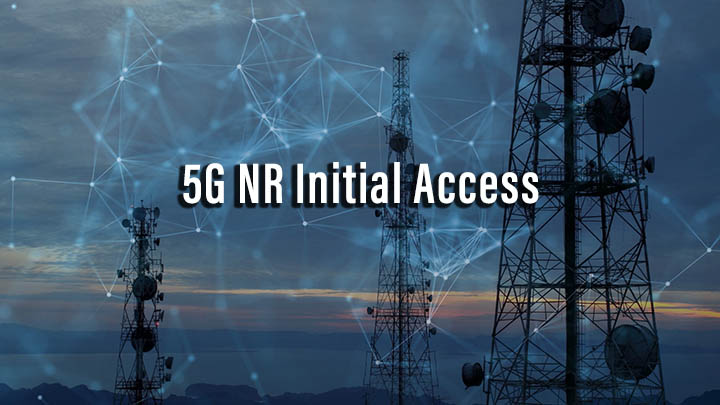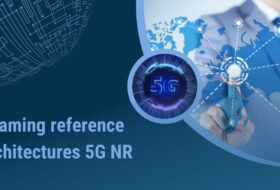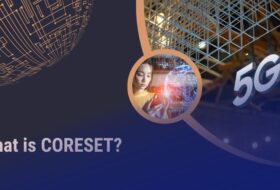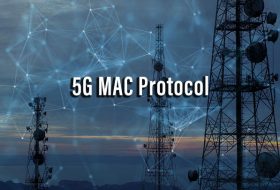How 5G NR initial Cell Search process work?
For the initial access case (idle mode), the UE should start by the cell search procedure. By using the PSS, SSS, and specific synchronization algorithms, the UE can estimate and correct the frequency and time offsets.
Cell Search
The UE searches for a specific frequency based on a synchronization raster defined in 3GPP TS 38.104.
Range of frequencies (MHz) | SS block frequency position SSREF | GSCN | Range of GSCN |
0 – 3000 | N * 1200 kHz + M * 50 kHz, N = 1:2499, M ϵ {1,3,5} (Note) | 3N + (M-3)/2 | 2 – 7498 |
3000 – 24250 | 3000 MHz + N * 1.44 MHz, | 7499 + N | 7499 – 22255 |
24250 – 100000 | 24250.08 MHz + N * 17.28 MHz, | 22256 + N | 22256 – 26639 |
NOTE: The default value for operating bands that only support SCS spaced channel raster(s) is M=3. | |||
Synchronization raster entries for each operating band
NR operating band | SS Block SCS | SS Block pattern | Range of GSCN (First – – Last) |
n1 | 15 kHz | Case A | 5279 – <1> – 5419 |
n2 | 15 kHz | Case A | 4829 – <1> – 4969 |
n3 | 15 kHz | Case A | 4517 – <1> – 4693 |
n5 | 15 kHz | Case A | 2177 – <1> – 2230 |
30 kHz | Case B | 2183 – <1> – 2224 | |
n7 | 15 kHz | Case A | 6554 – <1> – 6718 |
n8 | 15 kHz | Case A | 2318 – <1> – 2395 |
n12 | 15 kHz | Case A | 1828 – <1> – 1858 |
n14 | 15 kHz | Case A | 1901 – <1> – 1915 |
n18 | 15kHz | CaseA | 2156 – <1> – 2182 |
n20 | 15 kHz | Case A | 1982 – <1> – 2047 |
n25 | 15 kHz | Case A | 4829 – <1> – 4981 |
n26 | 15 kHz | Case A | 2153 – <1> – 2230 |
n28 | 15 kHz | Case A | 1901 – <1> – 2002 |
n29 | 15 kHz | Case A | 1798 – <1> – 1813 |
n30 | 15 kHz | Case A | 5879 – <1> – 5893 |
n34 | 15 kHz | Case A | 5030 – <1> – 5056 |
n38 | 15 kHz | Case A | NOTE 2 |
30 kHz | Case C | 6437 – <1> – 6538 | |
n39 | 15 kHz | Case A | 4706 – <1> – 4795 |
n40 | 30 kHz | Case C | 5762 – <1> – 5989 |
n41 | 15 kHz | Case A | 6246 – <3> – 6717 |
30 kHz | Case C | 6252 – <3> – 6714 | |
n48 | 30 kHz | Case C | 7884 – <1> – 7982 |
n50 | 30 kHz | Case C | 3590 – <1> – 3781 |
n51 | 15 kHz | Case A | 3572 – <1> – 3574 |
n53 | 15 kHz | Case A | 6215 – <1> – 6232 |
n65 | 15 kHz | Case A | 5279 – <1> – 5494 |
n66 | 15 kHz | Case A | 5279 – <1> – 5494 |
30 kHz | Case B | 5285 – <1> – 5488 | |
n70 | 15 kHz | Case A | 4993 – <1> – 5044 |
n71 | 15 kHz | Case A | 1547 – <1> – 1624 |
n74 | 15 kHz | Case A | 3692 – <1> – 3790 |
n75 | 15 kHz | Case A | 3584 – <1> – 3787 |
n76 | 15 kHz | Case A | 3572 – <1> – 3574 |
n77 | 30 kHz | Case C | 7711 – <1> – 8329 |
n78 | 30 kHz | Case C | 7711 – <1> – 8051 |
n79 | 30 kHz | Case C | 8480 – <16> – 8880 |
n90 | 15 kHz | Case A | 6246 – <1> – 6717 |
30 kHz | Case C | 6252 – <1> – 6714 | |
n91 | 15 kHz | Case A | 3572 – <1> – 3574 |
n92 | 15 kHz | Case A | 3584 – <1> – 3787 |
n93 | 15 kHz | Case A | 3572 – <1> – 3574 |
n94 | 15 kHz | Case A | 3584 – <1> – 3787 |
SYNCHRONIZATION SIGNALS :
- Similar to 4G networks, the synchronization signals PSS and SSS are used in 5G NR systems to help the UEs to get radio frame boundaries and to detect the cell identity (ID .
- In 5G NR systems, each radio cell is identified by a cell ID from 1008 IDs that are arranged into 336 different groups.
- Each group is identified by the cell ID group,N(1,ID) 0 to 335 , and consists of three different sectors, which are specified by the cell ID sector, N(2)
ID 2 0 to 2. -
PSS:
- Similar to 4G, 5G NR PSS is a physical layer-specific signal and helps UE to get radio frame boundary & to detect the cell ID sector.
- NR PSS consisit of one of the three 127 symbols m- sequence and is allocated on the first symbol of each SSB and on 127 subcarriers.
Please check our PSS article for more detail description(https://cafetele.com/5g-nr-primary-synchronization-signalpss/)
SSS:
- Similar to 4G SSS, 5G NR SSS issued to detect the cell ID group,
- However the 5G NR PSS consists of one of 336 127 symbol gold sequences and is allocated on the third symbol of each SSB and on 127 subcarriers.
- For more detail about SSS please check this link https://cafetele.com/secondary-synchronization-signal-nr/
After decoding PSS, the UE can detect the cell ID sector, then by using the detected cell ID, the UE can decode SSSand detect the cell ID group, hence it can finally detect the CELL ID.
After detecting cell ID, the UE should identify the candidate SSB within the SS burst (set of L SSB).
After detecting the PSS/SSS UE knows, in addition to the physical cell ID, the timing of the PBCH. The PBCH carrying MIB, and integrated part of SS/PBCH block, is used for signalling the MOST essential system related to access frequency position and timing
check PBCH section over here https://cafetele.com/pssssspbch-overview/
Master information Block: https://cafetele.com/mib-master-information-block/
SI Acquisition:
A gNodeB can deliver SI in periodic broadcast mode or on-demand delivery mode. Therefore, a UE can also acquire SI in two ways.
The UE searches for a cell, parses the MIB, and checks the cell status.
- If the value of CellBarred is barred, the UE stops SI acquisition.
- Otherwise, the UE goes to the next step.
The UE attempts to parse SIB1 using the parameters carried in the MIB.
- If the UE parses SIB1 successfully, it stores the related information and performs the subsequent step.
- Otherwise, it stops SI acquisition.
The UE attempts to acquire other SIBs according to their broadcast mode indicated in SIB1.
- If the periodic broadcast mode is used for other SIBs, the UE attempts to receive and parse SI in the OSI search space indicated in SIB1.
Note: Complete Article will update soon till RRC connection release or I will make part 2.







